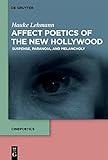Affect Poetics of the New Hollywood : Suspense, Paranoia, and Melancholy / Hauke Lehmann.
Material type: TextSeries: Cinepoetics – English edition ; 7Publisher: Berlin ; Boston : De Gruyter, [2019]Copyright date: ©2020Description: 1 online resource (VIII, 276 p.)Content type:
TextSeries: Cinepoetics – English edition ; 7Publisher: Berlin ; Boston : De Gruyter, [2019]Copyright date: ©2020Description: 1 online resource (VIII, 276 p.)Content type: - 9783110579604
- 9783110579727
- 9783110580761
- 791.43019 23
- PN1995.9.A8 L4413 2020
- PN1995.9.A8 L4413 2020
- online - DeGruyter
- Issued also in print.
| Item type | Current library | Call number | URL | Status | Notes | Barcode | |
|---|---|---|---|---|---|---|---|
 eBook
eBook
|
Biblioteca "Angelicum" Pont. Univ. S.Tommaso d'Aquino Nuvola online | online - DeGruyter (Browse shelf(Opens below)) | Online access | Not for loan (Accesso limitato) | Accesso per gli utenti autorizzati / Access for authorized users | (dgr)9783110580761 |
Frontmatter -- Contents -- Acknowledgments -- 1 Splitting the Spectator -- 2 Suspense: Forms of Cinematic Thinking -- 3 Paranoia: Forms of Mediatization -- 4 Melancholy: Ways of Perceiving History -- 5 A History of Feeling -- List of figures -- Bibliography -- Subject index -- Name index
restricted access online access with authorization star
http://purl.org/coar/access_right/c_16ec
How is affective experience produced in the cinema? And how can we write a history of this experience? By asking these questions, this study by Hauke Lehmann aims at rethinking our conception of a critical period in US film history – the New Hollywood: as a moment of crisis that can neither be reduced to economic processes of adaption nor to a collection of masterpieces. Rather, the fine-grained analysis of core films reveals the power of cinematic images to affect their audiences – to confront them with the new. The films of the New Hollywood redefine the divisions of the classical genre system in a radical way and thereby transform the way spectators are addressed affectively in the cinema. The study describes a complex interplay between three modes of affectivity: suspense, paranoia, and melancholy. All three, each in their own way, implicate spectators in the deep-seated contradictions of their own feelings and their ways of being in the world: their relations to history, to society, and to cultural fantasy. On this basis, Affect Poetics of the New Hollywood projects an original conception of film history: as an affective history which can be re-written up to the present day.
Issued also in print.
Mode of access: Internet via World Wide Web.
In English.
Description based on online resource; title from PDF title page (publisher's Web site, viewed 25. Jun 2024)


